FY2021 Annual Report
Complex Fluids and Flows
Assistant Professor Marco Edoardo Rosti
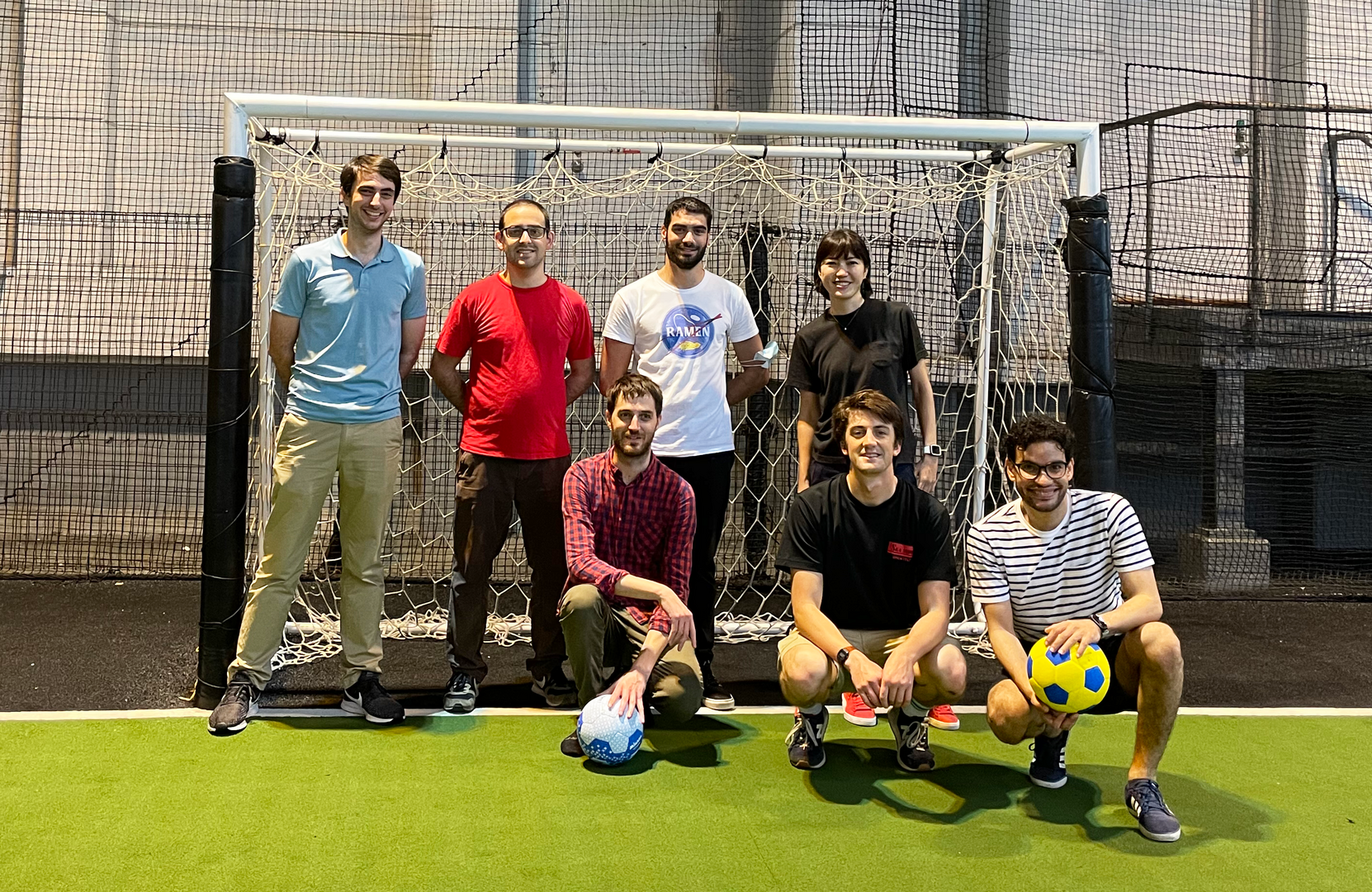
Abstract
This is the second full fiscal year since the foundation of the Complex Fluids and Flows Unit (CFFU). In this period, the unit welcomed Yoshimura Hideyuki, Morie Koseki, Jean-Paul van Woensel, Fabian Hillebrand and Ilhem Nadia Rabehi as rotation students, Armin Shahmardi as Visiting Research Student and Giulio Foggi Rota as Research Intern.
The Unit research has mainly focused on multiphase systems in classical and non-Newtonian turbulent flows. The unit continued to work on the turbulence modulation by the presence of a dispersed phase: particle and fiber suspensions and two-liquid systems have been considered. In parallel to this topic, the unit worked on the numerical methods needed to simulate such systems and to the development of a new code able to simulate dense suspensions, now freely available at https://github.com/marco-rosti/CFF-Ball-0x. Another branch of the research focused on the fluid dynamics of virus dispersion, motivated by the ongoning COVID-19 pandemic.
In this period, 15 manuscripts were published in international journals, including 1 Physical Review X and 1 Physical Review Letters, with 4 publications highlighted as Editors’ suggestion and Featured article, 2 appearing as Journal covers and 1 broadcasted by an international news outlet. Furthermore, the unit members were invited to give 4 invited talks and 4 seminars in international conferences and universities. Finally, 13 international guests were invited to present their works in (online) seminars.
1. Staff
- Dr. Alessandro Monti, Postdoctoral Researcher
- Dr. Stefano Olivieri, Postdoctoral Researcher
- Dr. Giovanni Soligo, Postdoctoral Researcher
- Mr. Ianto Cannon, Graduate Student
- Mr. Mohamed Abdelgawad, Graduate Student
- Ms. Megumi Ikeda, Administrative Assistant
2. Collaborations
2.1 Bubbly turbulent flows
- Type of collaboration: Joint research
- Researchers
- Dr. Marco Crialesi-Esposito, KTH Royal Institute of Technology
- Prof. Luca Brandt, KTH Royal Institute of Technology
- Prof. Sergio Chibbaro, University Paris-Saclay
- Mr. Ianto Cannon, OIST
- Prof. Marco E. Rosti, OIST
2.2 Immiscible Rayleigh-Taylor flows
- Type of collaboration: Joint research
- Researchers
- Mr. Stefano Brizzolara, ETH Zurich
- Prof. Markus Holzner, KTH Royal Institute of Technology
- Prof. Andrea Mazzino, University of Genova
- Prof. Marco E. Rosti, OIST
2.3 Rayleigh-Taylor instability
- Type of collaboration: Joint research
- Researchers
- Prof. Pinaki Chakraborty, OIST
- Prof. Gustavo Gioia, OIST
- Prof. Marco E. Rosti, OIST
2.4 Turbulent puffs
- Type of collaboration: Joint research
- Researchers
- Prof. Andrea Mazzino, University of Genova
- Prof. Marco E. Rosti, OIST
2.5 Viscoelastic turbulence
- Type of collaboration: Joint research
- Researchers
- Prof. Dhrubaditys Mitra, NORDITA
- Prof. Prasad Perlekar, TIFR Centre for Interdisciplinary Sciences
- Prof. Marco E. Rosti, OIST
2.6 Rheology of droplets in non-Newtonian liquids
- Type of collaboration: Joint research
- Researchers
- Prof. Shu Takagi, The University of Tokyo
- Prof. Marco E. Rosti, OIST
2.7 Eulerian immersed boundary method
- Type of collaboration: Joint research
- Researchers
- Prof. Shu Takagi, The University of Tokyo
- Mr. Naoki Hori, The University of Tokyo
- Prof. Marco E. Rosti, OIST
2.8 Haemorheology of red blood cells
- Type of collaboration: Joint research
- Researchers
- Prof. Naoki Takeishi, Osaka University
- Prof. Luca Brandt, KTH Royal Institute of Technology
- Prof. Marco E. Rosti, OIST
2.9 The effect of porous walls on particle suspensions
- Type of collaboration: Joint research
- Researchers
- Prof. Parisa Mirbod, University of Illinois at Chicago
- Prof. Luca Brandt, KTH Royal Institute of Technology
- Prof. Marco E. Rosti, OIST
2.10 A deep-learning model for turbulent channel flows over porous walls
- Type of collaboration: Joint research
- Researchers
- Prof. Soledad Le Clainche, Universidad Politecnica de Madrid
- Prof. Luca Brandt, KTH Royal Institute of Technology
- Prof. Marco E. Rosti, OIST
2.11 Reduced order modeling of turbulent jets
- Type of collaboration: Joint research
- Researchers
- Prof. Soledad Le Clainche, Universidad Politecnica de Madrid
- Mr. Christian Amor Rodriguez, OIST
- Prof. Marco E. Rosti, OIST
2.12 Wall-bounded 2D turbulent flows
- Type of collaboration: Joint research
- Researchers
- Prof. Guido Boffetta, University of Torino
- Prof. Stefano Musacchio, University of Torino
- Prof. Andrea Mazzino, University of Genova
- Prof. Marco E. Rosti, OIST
2.13 Fibers in turbulent flows
- Type of collaboration: Joint research
- Researchers
- Prof. Andrea Mazzino, University of Genova
- Prof. Luca Brandt, KTH Royal Institute of Technology
- Mr. Stefano Brizzolara, WSL and ETH Zurich
- Prof. Markus Holzner, WSL and ETH Zurich
- Dr. Stefano Olivieri, OIST
- Prof. Marco E. Rosti, OIST
2.14 Simulation of expiratory events
- Type of collaboration: Joint research
- Researchers
- Prof. Andrea Mazzino, University of Genova
- Dr. Mattia Cavaiola, University of Genova
- Dr. Agnese Seminara, CNRS and Université Côte d’Azur
- Dr. Stefano Olivieri, OIST
- Prof. Marco E. Rosti, OIST
2.15 Grid-induced turbulence
- Type of collaboration: Joint research
- Researchers
- Prof. Andrea Mazzino, University of Genova
- Prof. Francesco Viola, Gran Sasso Science Institute
- Dr. Stefano Olivieri, OIST
- Prof. Marco E. Rosti, OIST
2.16 Hydrodynamics of clownfish
- Type of collaboration: Joint research
- Researchers
- Prof. Vincent Laudet, OIST
- Dr. Manon Mercader, OIST
- Dr. Stefano Olivieri, OIST
- Prof. Marco E. Rosti, OIST
2.17 Hydrodynamics of garden eels
- Type of collaboration: Joint research
- Researchers
- Prof. Satoshi Mitarai, OIST
- Dr. Heng Wu, OIST
- Mr. Kota Ishikawa, OIST
- Dr. Stefano Olivieri, OIST
- Dr. Alessandro Monti, OIST
- Prof. Marco E. Rosti, OIST
2.18 Flow-structure interaction of perforated plates
- Type of collaboration: Joint research
- Researchers
- Prof. Leonardo Chamorro, University of Illinois at Urbana-Champaign
- Dr. Jeffrey Cheng, University of Illinois at Urbana-Champaign
- Dr. Stefano Olivieri, OIST
- Prof. Marco E. Rosti, OIST
2.19 Turbulent flows laden with drops and bubbles
- Type of collaboration: Joint research
- Researchers
- Dr. Alessio Roccon, TU Wien and University of Udine
- Prof. Alfredo Soldati, TU Wien and University of Udine
- Dr. Giovanni Soligo, OIST
2.20 Turbulent flows laden with drops and bubbles
- Type of collaboration: Joint research
- Researchers
- Ms. Francesca Mangani, TU Wien
- Dr. Alessio Roccon, TU Wien and University of Udine
- Prof. Alfredo Soldati, TU Wien and University of Udine
- Dr. Giovanni Soligo, OIST
2.21 Risk evaluation of short-range exposure to airborne COVID-19
- Type of collaboration: Joint research
- Researchers
- Mr. Jietuo Wang, University of Padua
- Prof. Francesco Picano, University of Padua
- Dr. Alipour Mobin, TU Wien and University of Udine
- Dr. Alessio, TU Wien and University of Udine
- Dr. Marco de Paoli, TU Wien and University of Udine
- Prof. Alfredo Soldati, TU Wien and University of Udine
- Dr. Giovanni Soligo, OIST
2.22 Rheology of dense colloidal suspensions
- Type of collaboration: Joint research
- Researchers
- Prof. Amy Shen, OIST
- Dr. Vikram Rathee, OIST
- Dr. Alessandro Monti, OIST
- Prof. Marco Edoardo Rosti, OIST
2.23 Turbulent canopy flows
- Type of collaboration: Joint research
- Researchers
- Prof. Alfredo Pinelli, City, University of London
- Dr. Mohammad Omidyeganeh, City, University of London
- Mr. Shane Nicholas, City, University of London
- Dr. Alessandro Monti, OIST
- Prof. Marco Edoardo Rosti, OIST
2.24 Structure of turbulent canopy flows
- Type of collaboration: Joint research
- Researchers
- Dr. Soledad Le Clainche, Universidad Politecnica de Madrid
- Mr Christian Amor Rodriguez, OIST
- Dr. Alessandro Monti, OIST
- Prof Marco Edoardo Rosti, OIST
2.25 Turbulent pulsating flow
- Type of collaboration: Joint research
- Researchers
- Prof. Maurizio Quadrio, Politecnico di Milano
- Mr. Giulio Foggi Rota, Politecnico di Milano
- Dr. Alessandro Monti, OIST
- Prof. Marco Edoardo Rosti, OIST
3. Activities and Findings
3.1 Turbulence in a fluid puff
Turbulent puffs are ubiquitous in everyday life phenomena and understanding their dynamics is important in a variety of situations ranging from industrial processes to pure and applied science. We exploit theory and numerics in concert to predict and validate the space-time scaling behaviors of both velocity and temperature structure functions including intermittency corrections. Excellent agreement between theory and simulations is found. Our results fill the gap to pass from bulkproperties to two-point statistical observables and are expected to have a profound impact on developing evaporation models for virus-containing droplets carried by a turbulent puff, with benefits to the comprehension of the airborne route of virus contagion.
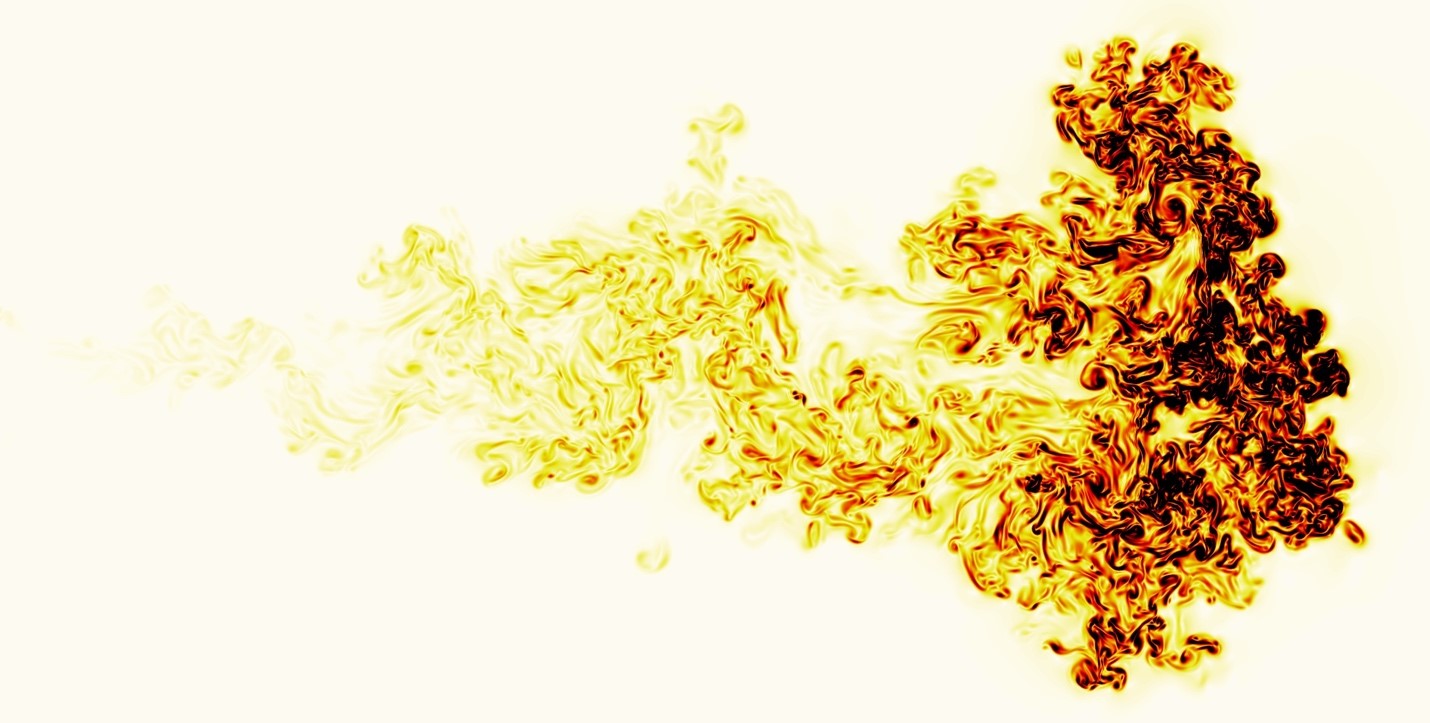
Figure 3.1: Side view of a puff, with the color contour showing the magnitude of the vorticity field.
3.2 Turbulent channel flows of an elastoviscoplastic fluid
Direct numerical simulations are carried out to study the effect of finite Weissenberg number on laminar and turbulent channel flows of an elastoviscoplastic fluid. In turbulent flow, we find that drag decreases with both Bingham and Weissenberg numbers, until the flow laminarises at high enough elastic and yield stresses. Hence, a higher drag reduction is achieved than in the viscoelastic flow at the same Weissenberg number. The drag reduction persists at Bingham numbers up to 20, in contrast to viscoplastic flow, where the drag increases in the laminar regime compared to a Newtonian flow. Moreover, elasticity affects the laminarization of an EVP flow in a non-monotonic fashion, delaying it at lower and promoting it at higher Weissenberg numbers. A hibernation phenomenon is observed in the EVP flow, leading to large changes in the unyielded regions. Finally, plasticity is observed to affect both low- and high-speed streaks equally, attenuating the turbulent dissipation and the fragmentation of turbulent structures.
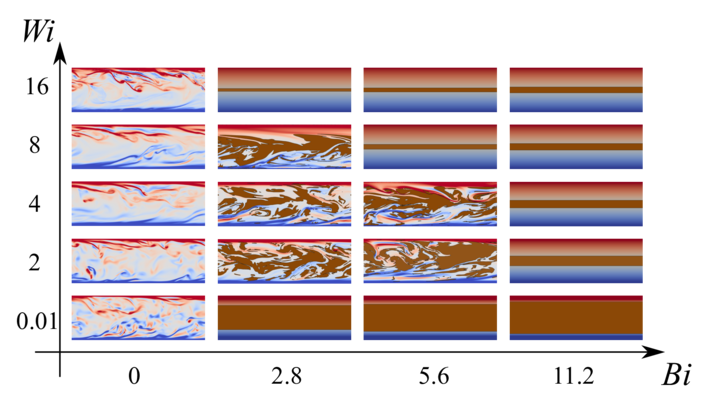
Figure 3.2: Contours of the instantaneous spanwise vorticity as a function of the Bingham and Weissenberg numbers.
3.3 Inelastic power-law emulsions in shear flows
We study the rheology of a two-fluid emulsion in semiconcentrated conditions; the solute is Newtonian while the solvent is an inelastic power-law fluid. The problem at hand is tackled by means of direct numerical simulations using the volume of fluid method. We show that the effective viscosity of the system increases for shear-thickening fluids and decreases for the shear-thinning ones for all the viscosity ratios considered. The changes in the emulsion viscosity are mainly due to modifications of the coalescence in the system obtained by changing the carrier fluid property: indeed, local large and low shear rates are found in the regions between two interacting droplets for shear-thickening and thinning fluids, respectively, resulting in increased and reduced local viscosity which ultimately affects the drainage time of the system. This process is independent of the nominal viscosity ratio of the two fluids and we show that it can not be understood by considering only the mean shear rate and viscosity of the two fluids across the domain, but the full spectrum of shear rate must be taken into account.

Figure 3.3: Top view of the computational domain with droplets; the left, middle and right panels show the instantaneous configuration of the droplets suspended in a shear-thinning, Newtonian and shear-thickening fluid.
3.4 Rheology of dense suspensions
A cutting-edge software that adopts an optimised searching algorithm is presented to tackle the Newton-Euler equations governing the dynamics of dense suspensions in Newtonian fluids. In particular, we propose an implementation of a fixed-radius near neighbours search based on an efficient counting sort algorithm with an improved symmetric search. The adopted search method drastically reduces the computational cost and allows an efficient parallelisation even on a single node through the multi-threading paradigm. Emphasis is also given to the memory efficiency of the code since the history of the contacts among particles has to be traced to model the frictional contributions, when dealing with dense suspensions of rheological interest that consider non-smooth interacting particles. The software has been successfully adopted in a combined experimental-numerical study, where we investigated the effect of the particle stability on the hysteresis of the shear thickening behavior in dense colloidal suspensions. Experimentally, the particle stability is manipulated by adding a simple monovalent salt (sodium chloride) in the silica suspension with varying concentrations. For repulsive and weakly attractive suspensions, the flow behavior is history independent and the shear thickening behavior does not exhibit hysteresis. However, significant hysteresis is observed in rheological measurements for strongly attractive suspensions, with shear history playing a critical role due to the dynamic nature of particle clusters, resulting in time dependent hysteresis behavior. By performing numerical simulations, where the particle stability is manipulated by tuning the relative strength of the colloidal forces, we find that this hysteresis behavior arises due to the competition among shear, electrostatic repulsive, van der Waals attractive, and frictional contact forces..
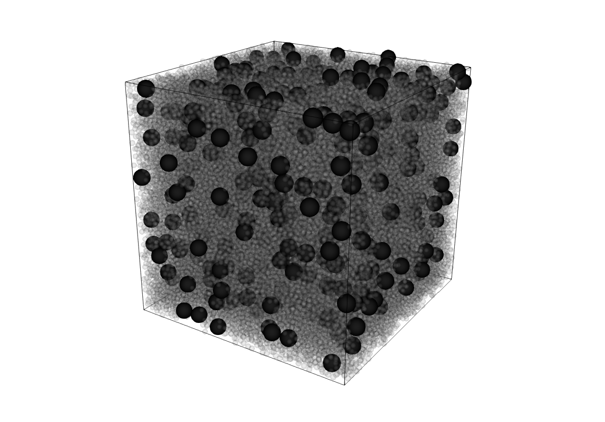
Figure 3.4: Snapshot of a dense particle suspension with 65536 particles with size ratio 3.
3.5 The effect of coalescence in turbulent bubbly channel flows
We study the effect of droplet coalescence on turbulent wall-bounded flows by means of direct numerical simulations. In particular, the volume-of-fluid and front-tracking methods are used to simulate turbulent channel flows containing coalescing and non-coalescing droplets, respectively. We find that coalescing droplets have a negligible effect on the drag, whereas the non-coalescing ones steadily increase drag as the volume fraction of the dispersed phase increases. We explain this by looking at the wall-normal location of droplets in the channel and show that non-coalescing droplets enter the viscous sublayer, generating an interfacial shear stress, which reduces the budget for viscous stress in the channel. On the other hand, coalescing droplets migrate toward the bulk of the channel forming large aggregates, which hardly affect the viscous shear stress while damping the Reynolds shear stress. We prove this by relating the mean viscous shear stress to the centerline velocity.

Figure 3.5: A snapshot of the simulation domain for a 10% suspension of (left) coalescing and (right) non-coalescing droplets.
3.6 Flow-structure interaction in grid turbulence
A fully resolved direct numerical simulation approach for investigating flexible bodies forced by a turbulent incoming fl1ow is designed to study the flapping motion of a flexible flag at the moderate Reynolds number. The incoming turbulent flow is generated by placing a passive grid at the inlet of the numerical domain and the turbulence level of the flow, impacting that the flag can be controlled by changing its downstream distance from the grid. The computational framework is based on the immersed boundary method for dealing with arbitrary geometries and implemented using a graphics-processing-unit accelerated parallelization to increase the computational efficiency. The grid-induced turbulent flow is first characterized by means of comparison with well-known results for decaying turbulence and a scale-by-scale analysis. Then, the flag-in-the-wind problem is revisited by exploring the effect of the turbulence intensity on self-sustained flapping. While the latter is still manifesting under strong fluctuations, the main features of the oscillation (including its amplitude and frequency) are altered by turbulence, whose fingerprint can also be qualitatively detected by spectral analysis. Besides their relevance for advancing the fundamental understanding of the fluid–structure interaction in turbulence, these findings have potential impact for related applications, e.g., aeroelastic energy harvesting or flow control techniques.

Figure 3.6: Fluid–structure interaction between a flexible flag and the turbulent flow generated using a passive grid.
3.7 Fiber Tracking Velocimetry
We propose and validate a novel experimental technique to measure two-point statistics of turbulent flows. It consists of spreading rigid fibers in the flow and tracking their position and orientation in time and is therefore named “fiber tracking velocimetry.” By choosing different fiber lengths, i.e., within the inertial or dissipative range of scales, the statistics of turbulence fluctuations at the selected length scale can be probed accurately by simply measuring the fiber velocity at its two ends and projecting it along the transverse-to-fiber direction. By means of fully resolved direct numerical simulations and experiments, we show that these fiber-based transverse velocity increments are statistically equivalent to the (unperturbed) flow transverse velocity increments. Moreover, we show that the turbulent energy-dissipation rate can be accurately measured exploiting sufficiently short fibers. The technique is tested against standard particle tracking velocimetry (PTV) of flow tracers with excellent agreement. Our technique overcomes the well-known problem of PTV to probe two-point statistics reliably because of the fast relative diffusion in turbulence that prevents the mutual distance between particles to remain constant at the length scale of interest. This problem, making it difficult to obtain converged statistics for a fixed separation distance, is even more dramatic for natural flows in open domains. A prominent example is oceanic currents, where drifters (i.e., the tracer-particle counterpart used in field measurements) disperse quickly, but at the same time their number has to be limited to save costs. Inspired by our laboratory experiments, we propose pairs of connected drifters as a viable option to solve the issue.
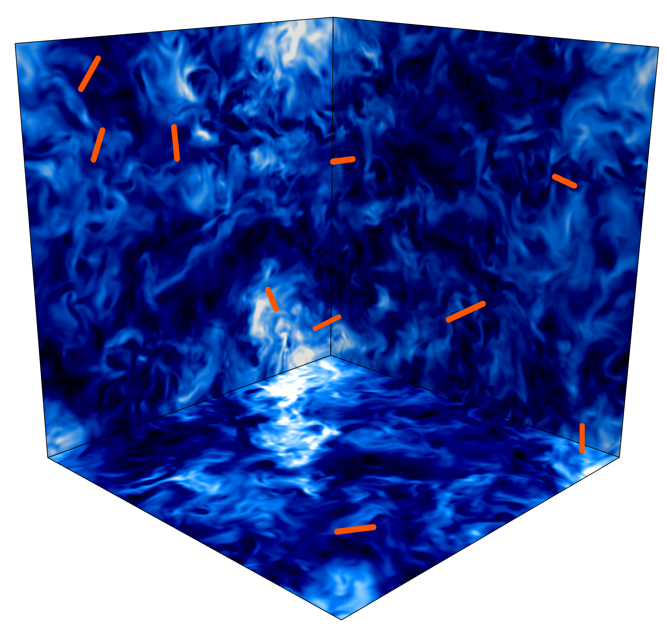
Figure 3.7: Snapshot from numerical simulation of a homogeneous turbulent flow where rigid fibers are released and tracked over time in order to statistically characterize the flow structures of comparable size.
3.8 Universal flapping states of elastic fibers in turbulence
We study the fully coupled dynamics between a fully developed turbulent flow and an ensemble of immersed flexible fibers. We vary the concentration of the suspension, the mechanical properties, and the length of the fibers in a vast parametric range. For all configurations, the fiber dynamics falls in only two possible dynamical states: (i) the fiber manifests its natural response to the flow forcing or (ii) its motion fully synchronizes to the hydrodynamic timescales of the turbulent flow. This scenario holds for both a dilute condition, where the carrier flow is not affected by the fluid–structure interaction, as well as in the case where the flow is substantially altered by the presence of immersed objects. Such a backreaction effect can be macroscopically modeled in terms of the mass fraction of the suspension. Our results can be readily extended to any elastic objects interacting with fluid turbulence.

Figure 3.8: Direct numerical simulation of flexible fibers dispersed in homogeneous isotropic turbulence. Instantaneous visualization of fibers and vortical flow structures.
3.9 Role of barriers in the spread of droplets
State-of-the-art direct numerical simulations are exploited to study the role of barriers on the airborne spread of virus-containing droplets. Our study is motivated by recent findings pointing to the key role of turbulence in dictating the final fate of virus-containing droplets in violent human exhalations. Here, all active scales of motion have been explicitly taken into account, including their interplay with the droplet evaporation process occurring once droplets are emitted in a drier ambient air, and accounting for the time-varying droplet inertia due to the water loss via evaporation. We show that barriers commonly used to mitigate the airborne spread of the virus cause nontrivial dynamical effects influencing the final reach of the virus-containing droplets, not always being beneficial to this aim. These conclusions do depend on the relative humidity of the ambient condition, and in particular whether the ambient humidity is above or below the so-called efflorescence relative humidity. Our findings provide a physically based answer to the question on how effective barriers are to protect people from airborne virus transmission in indoor environments.

Figure 3.9: Virus-containing droplet trajectories computed by means of high-resolution DNS for several representative configurations with and without barrier.
4. Publications
4.1 Journals
- A. Shahmardi, M. E. Rosti, O. Tammisola, L. Brandt, "A fully Eulerian hybrid immersed boundary-phase field model for contact line dynamics on complex geometries" DOI: 10.1016/j.jcp.2021.110468
- M. Villone, M. E. Rosti, O. Tammisola, L. Brandt, "Numerical simulations of small amplitude oscillatory shear flow of suspensions of rigid particles in non-Newtonian liquids at finite inertia" DOI: 10.1122/8.0000257
- S. Olivieri, A. Mazzino, M. E. Rosti, "Universal flapping states of elastic fibers in modulated turbulence" DOI: 10.1063/5.0058835
- I. Cannon, D. Izbassarov, O. Tammisola, L. Brandt, M. E. Rosti, "The effect of droplet coalescence on drag in turbulent channel flows" DOI: 10.1063/5.0058632
- S. Olivieri, F. Viola, A. Mazzino, M. E. Rosti, "Direct numerical simulation of flapping flags in grid-induced turbulence" DOI: 10.1063/5.0060181
- G. Soligo, A. Roccon, A. Soldati, "Turbulent flows with drops and bubbles: What numerical simulations can tell us—Freeman Scholar Lecture" DOI: 10.1115/1.4050532
- J. Wang, M. Alipour, G. Soligo, A. Roccon, M. De Paoli, F. Picano, A. Soldati, "Short-range exposure to airborne virus transmission and current guidelines" DOI: 10.1073/pnas.2105279118
- M. E. Rosti, S. Takagi, "Shear-thinning and shear-thickening emulsions in shear flows" DOI: 10.1063/5.0063180
- A. Mazzino, M. E. Rosti, "Unraveling the secrets of turbulence in a fluid puff" DOI: 10.1103/PhysRevLett.127.094501
- V. Rathee, A. Monti, M. E. Rosti, A. Q. Shen, "Shear thickening behavior in dense repulsive and attractive suspensions of hard spheres" DOI: 10.1039/D1SM00971K
- S. Brizzolara, M. E. Rosti, S. Olivieri, L. Brandt, M. Holzner, A. Mazzino, "Fiber Tracking Velocimetry for two-point statistics of turbulence" DOI: 10.1103/PhysRevX.11.031060
- D. Izbassarov, M. E. Rosti, L. Brandt, and O. Tammisola, "Effect of finite Weissenberg number on turbulent channel flows of an elastoviscoplastic fluid" DOI: 10.1017/jfm.2021.789
- A. Monti, V. Rathee, A. Q. Shen, M. E. Rosti, "A fast and efficient tool to study the rheology of dense suspensions" DOI: 10.1063/5.0065655
- M. Cavaiola, S. Oliveiri, J. Guerrero, A. Mazzino, M. E. Rosti, "Role of barriers in the airborne spread of virus-containing droplets: a study based on high-resolution direct numerical simulations" DOI: 10.1063/5.0072840
- N. Hori, M. E. Rosti, S. Takagi, "An Eulerian-based immersed boundary method for particle suspensions with implicit lubrication model" DOI: 10.1016/j.compfluid.2021.105278
- N. Scapin, F. Dalla Barba, G. Lupo, M. E. Rosti, C. Duwig, L. Brandt, "Finite-size evaporating droplets in weakly compressible homogeneous shear turbulence" DOI: 10.1017/jfm.2021.1140
- A. Mazzino, M. E. Rosti, "Puff turbulence in the limit of strong buoyancy" DOI: 10.1098/rsta.2021.0093
4.2 Books and other one-time publications
Nothing to report
4.3 Oral and Poster Presentations
Invited Talks
- M. Abdelgawad, "Droplet breakup limits in simple shear flows" ESCHM-ISCH-ISB 2021, Fukuoka, Japan, Online (2021.07.07)
- A. Monti, "Rheology of Dense Suspensions: non-trivial phenomena in the shear-thickening regime" ESCHM-ISCH-ISB 2021, Fukuoka, Japan, Online (2021.07.07)
- M. E. Rosti, "Deformable particle suspensions" ESCHM-ISCH-ISB 2021, Fukuoka, Japan, Online (2021.07.07)
- M. E. Rosti, "Puff turbulence" Mathematics and Physics of Fluids, Online (2021.11.01)
Contributed Talks
- I. Cannon, "Coalescence reduces drag in turbulent bubbly channel flows" EUROMECH Colloquium 621 - Transport and fluxes in dispersed turbulent flow, Iceland, Online (2021.07.01)
- S. Olivieri, "Turbulence in a network of rigid fibers" ICTAM 2020+1, Online (2021.08.23)
- A. Monti, "Turbulence suppression via compliant lubricating layer" ICTAM 2020+1, Online (2021.08.25)
- M. E. Rosti, "Droplets in shear flows" ICTAM 2020+1, Online (2021.08.26)
- S. Olivieri, "Flapping flag in grid-generated turbulent flow" Annual Meeting of the Japanese Society of Fluid Mechanics, Online (2021.09.21)
- I. Cannon, "Coalescence and drag in bubbly channel flows" Annual Meeting of the Japanese Society of Fluid Mechanics, Online (2021.09.21)
- G. Soligo, "Numerical simulations of jets in non-Newtonian fluid" Annual Meeting of the Japanese Society of Fluid Mechanics, Online (2021.09.22)
- M. E. Rosti, "Turbulent puffs" Annual Meeting of the Japanese Society of Fluid Mechanics, Online (2021.09.23)
- S. Olivieri, "Spreading of polydisperse droplets in a turbulent puff of saturated exhaled air" HPCI Project Report Meeting, Online (2021.10.28)
- I. Cannon, "Direct numerical simulations of surfactants in bubbly tri-periodic turbulent flows" APS – DFD meeting, Online (2021.11.23)
- S. Olivieri, "Flapping flags in grid-induced turbulence" APS – DFD meeting, Online (2021.11.23)
- A. Monti, "Rheology of Dense, Bidispersed Suspensions: Segregative phenomenon induced by a flow perturbation" APS – DFD meeting, Online (2021.11.24)
- G. Soligo, "Volume of Fluid simulations of surfactant-laden interfaces" APS – DFD meeting, Online (2021.11.24)
- S. Olivieri "Computational study on the flapping motion of a flag in grid-induced turbulence" 7th International Conference on Jets, Wakes and Separated Flows (2022.03.15)
- G. Soligo "Numerical simulations of non-Newtonian jets" 7th International Conference on Jets, Wakes and Separated Flows (2022.03.15)
Seminars
- M. E. Rosti, "The fluid dynamics of social distancing" School of Aerospace Engineering (ETSIAE-UPM), Universidad Politécnica de Madrid, Online (2021.10.07)
- S. Olivieri, "On the dynamics of finite-size fibers in homogeneous turbulence and its application to novel flow measurement techniques" Department of Mechanical Science and Engineering, University of Illinois at Urbana-Champaign, Online (2021.10.29)
- S. Olivieri, "Flapping flags in grid-induced turbulent flow" Swiss Federal Institute of Technology Lausanne (EPFL), Online (2021.12.16)
- I. Cannon, "The effect of droplet coalescence on drag in turbulent channel flows" OIST Internal Seminar Series, Okinawa, Japan (2022.03.04)
5. Intellectual Property Rights and Other Specific Achievements
Nothing to report
6. Meetings and Events
6.1 Effects of the stenotic aortic valve on the left heart hemodynamics: a fluid-structure-electrophysiology approach
- Date: April 20 2021
- Venue: OIST, Online
- Speaker: Prof. Francesco Viola / Gran Sasso Science Institute, Italy
6.2 A low-cost, pseudo-volumetric reconstruction technique for velocity and density fields of variable-density turbulent flows
- Date: May 18 2021
- Venue: OIST, Online
- Speaker: Prof. Chris C.K. Lai / Georgia Institute of Technology, USA
6.3 Coagulation driven turbulence in binary fluid mixtures
- Date: June 10 2021
- Venue: OIST, Online
- Speaker: Prof. Dhrubaditya Mitra / NORDITA, Sweden
6.4 From particle migration over porous structures to flow transitions and instability in non-colloidal suspensions
- Date: July 13 2021
- Venue: OIST, Online
- Speaker: Prof. Parisa Mirbod / University of Illinois at Chicago, USA
6.5 Simulation of the fluid-mechanic behaviour of suspensions with deformable inclusions for applications in the science and technology of soft matter
- Date: September 21 2021
- Venue: OIST, Online
- Speaker: Dr. Massimiliano Villone / University of Naples Federico II, Italy
6.6 On the unsteady turbulence and structure/canopy interaction
- Date: October 26 2021
- Venue: OIST, Online
- Speaker: Prof. Leonardo P. Chamorro / University of Illinois at Urbana-Champaign, USA
6.7 Direct numerical simulation of bubble-induced turbulence
- Date: November 26 2021
- Venue: OIST, Online
- Speaker: Prof. Sergio Chibbaro / University Paris-Saclay, France
6.8 Hydrodynamic interaction and coalescence of rising bubbles in viscoelastic fluids: a numerical approach
- Date: December 07 2021
- Venue: OIST, Online
- Speaker: Dr. Wenjun Yuan / National University of Singapore, Singapore
6.9 Elastic instabilities in confined geometries
- Date: December 20 2021
- Venue: OIST, Online
- Speaker: Mr. Manish Kumar / Purdue University, USA
6.10 An Immersed Boundary Method for high-fidelity simulations with moving objects: application to active flow control
- Date: December 21 2021
- Venue: OIST, Online
- Speaker: Dr. Athanasios E. Giannenas / Imperial College London, UK
6.11 Lagrangian Studies in Active and Inertial Turbulence
- Date: December 22 2021
- Venue: OIST, Online
- Speaker: Mr. Rahul Kumar Singh / International Centre for Theoretical Sciences, Tata Institute of Fundamental Research, India
6.12 Weakly compressible simulation of evaporating droplets
- Date: February 15 2022
- Venue: OIST, Online
- Speaker: Mr. Nicolo Scapin / KTH Royal Institute of Technology, Sweden
6.13 Control of Wall Turbulence and associated Transport Processes
- Date: March 18 2022
- Venue: OIST, Online
- Speaker: Associate Prof.Yosuke Hasegawa / The University of Tokyo
7. Other
7.1 External Grants
- Marco Rosti, KAKENHI - Research Activity Start-up FY2020 “Modulation of turbulence by droplet coalescence” 20K22402
- Marco Rosti (co-PI, with Vincent Laudet as main PI), OIST KICKS 2021 “An Eco-Evo-Devo analysis of pigmentation pattern: the white bars of anemonefishes”
- Marco Rosti, Alessandro Monti, Stefano Olivieri, HPCI, "Direct numerical simulations of turbulent flows over flexible canopies" hp210025
- Marco Rosti, Stefano Olivieri, HPCI Fugaku General Access Projects (Trial Access) "Tuning and performance evaluation of large-scale multiphase turbulent flow simulations" hp210229
- Marco Rosti, Stefano Olivieri, Giovanni Soligo, HPCI Infectious Disease including COVID-19 Research Access: Urgent Call "Direct numerical simulations of barriers and masks" hp210246
- Marco Rosti, Ianto Cannon, Stefano Olivieri, HPCI Fugaku Small-Scale Projects "Turbulence modulation in multiphase flows at high Reynolds number" hp220099
7.2 Outreach
- Ianto Cannon, Morie Koseki - Unna Junior High School Science Club



